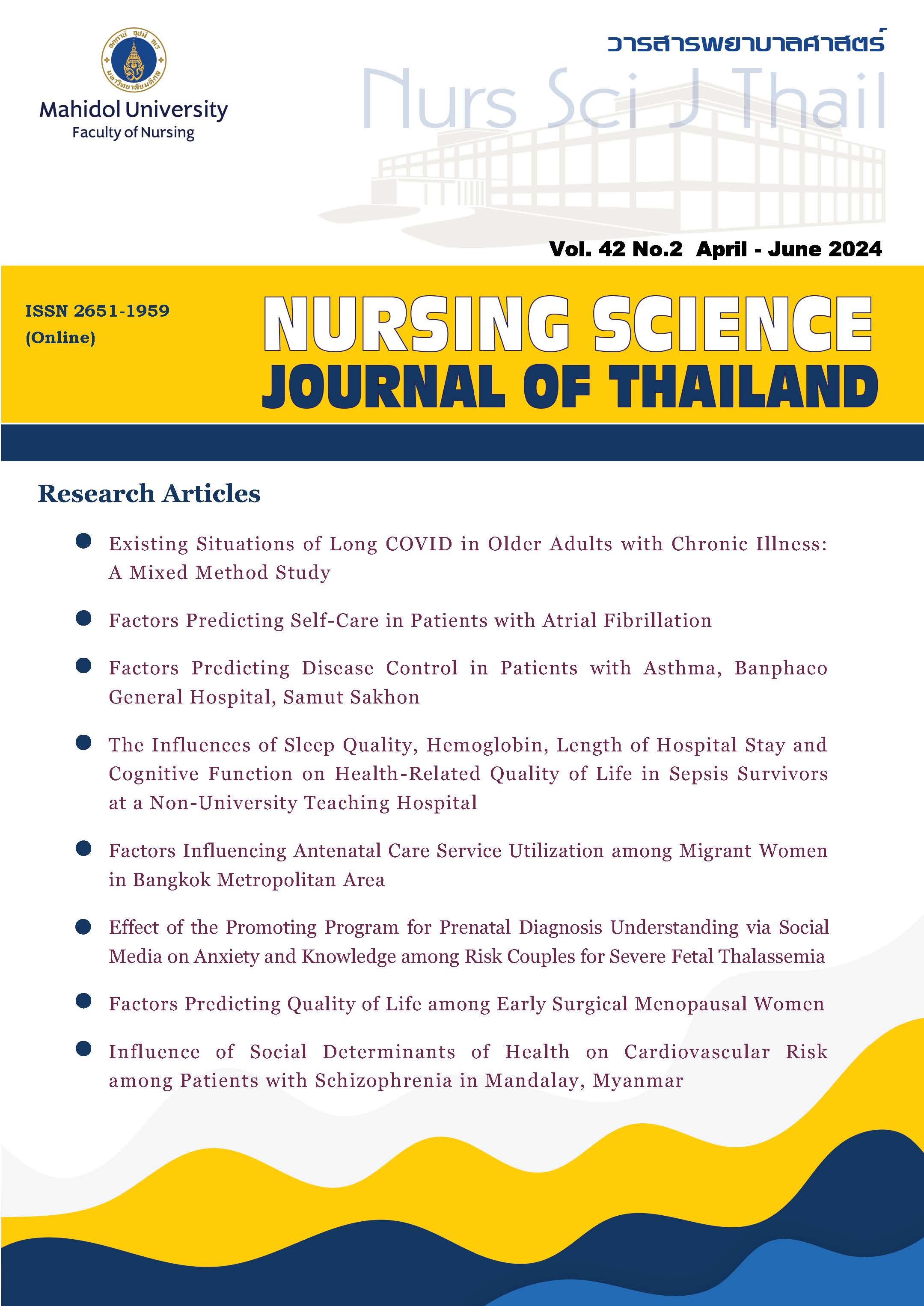ผลของโปรแกรมส่งเสริมความเข้าใจเกี่ยวกับการตรวจวินิจฉัยก่อนคลอดผ่านสื่อสังคมออนไลน์ต่อความวิตกกังวลและความรู้ของคู่เสี่ยงต่อการมีทารกเป็นโรคธาลัสซีเมียชนิดรุนแรง
Main Article Content
บทคัดย่อ
วัตถุประสงค์: เพื่อศึกษาผลของการใช้โปรแกรมการส่งเสริมความเข้าใจเกี่ยวกับการตรวจวินิจฉัยก่อนคลอดผ่านสื่อสังคมออนไลน์ต่อความวิตกกังวลและความรู้ของคู่เสี่ยงต่อการมีทารกเป็นโรคธาลัสซีเมียชนิดรุนแรง
รูปแบบการวิจัย: เป็นการศึกษาเชิงทดลอง
วิธีดำเนินการวิจัย: กลุ่มตัวอย่างเป็นสตรีตั้งครรภ์และสามีที่ได้รับการวินิจฉัยว่าเป็นคู่เสี่ยงต่อการมีทารกเป็นโรคธาลัสซีเมียชนิดรุนแรง ที่มารับบริการฝากครรภ์ที่โรงพยาบาลมหาวิทยาลัย 2 แห่ง จำนวน 61 คู่ (กลุ่มทดลอง 31 คู่ และกลุ่มควบคุม 30 คู่) เครื่องมือที่ใช้ในการวิจัย ได้แก่ แบบสอบถามข้อมูลส่วนบุคคล แบบวัดความวิตกกังวลขณะเผชิญ แบบวัดความรู้เรื่องโรคธาลัสซีเมียและวิธีการในการเตรียมตัวก่อนตรวจวินิจฉัยก่อนคลอด วิเคราะห์ข้อมูลโดย การทดสอบทีแบบสองกลุ่มอิสระและแบบสองกลุ่มสัมพันธ์กัน การทดสอบแมนวิทนีย์ การทดสอบวิลคอกซัน
ผลการวิจัย: โปรแกรมการส่งเสริมความเข้าใจเกี่ยวกับการตรวจวินิจฉัยก่อนคลอดผ่านสื่อสังคมออนไลน์ช่วยลดความวิตกกังวลของสตรีตั้งครรภ์และสามีอย่างมีนัยสำคัญทางสถิติ (p < .05) และช่วยเพิ่มความรู้ของสตรีตั้งครรภ์อย่างมีนัยสำคัญทางสถิติ (p = .001)
สรุปและข้อเสนอแนะ: โปรแกรมการส่งเสริมความเข้าใจเกี่ยวกับการตรวจวินิจฉัยก่อนคลอดผ่านสื่อสังคมออนไลน์ ช่วยลดความวิตกกังวลและเพิ่มความรู้ในสตรีตั้งครรภ์และสามีที่เป็นคู่เสี่ยงธาลัสซีเมีย จากผลการศึกษาเสนอแนะให้พยาบาลและผดุงครรภ์นำโปรแกรมไปใช้เป็นแนวทางในการดูแลคู่เสี่ยงต่อการมีทารกเป็นโรคธาลัสซีเมียพร้อมทั้งติดตามคู่เสี่ยงอย่างต่อเนื่องด้วยแบบประเมินและการติดตามทางสื่อออนไลน์
Article Details

อนุญาตภายใต้เงื่อนไข Creative Commons Attribution-NonCommercial-NoDerivatives 4.0 International License.
ลิขสิทธิ์: วารสารพยาบาลศาสตร์เป็นเจ้าของลิขสิทธิ์ในการเผยแพร่ผลงานที่ตีพิมพ์ ห้ามผู้ใดนำบทความที่ได้รับการตีพิมพ์ในวารสารพยาบาลศาสตร์ไปเผยแพร่ในลักษณะต่างๆ ดังต่อไปนี้ การส่งบทความไปตีพิมพ์เผยแพร่ที่อื่น การนำบทความเผยแพร่ออนไลน์ การถ่ายเอกสารบทความเพื่อกิจกรรมที่ไม่ใช่การเรียนการสอน ยกเว้นเสียแต่ได้รับอนุญาตจากวารสารพยาบาลศาสตร์

Disclaimer: เนื้อหาบทความหรือข้อคิดเห็นใดๆ ในวารสารพยาบาลศาสตร์ ถือเป็นความรับผิดชอบของผู้เขียน กองบรรณาธิการไม่จำเป็นต้องเห็นด้วยและไม่มีส่วนรับผิดชอบแต่อย่างใด
เอกสารอ้างอิง
Paiboonsukwong K, Jopang Y, Winichagoon P, Fucharoen S. Thalassemia in Thailand. Hemoglobin. 2022;46(1):53-7. doi: 10.1080/03630269.2022.2025824.
Thongsong T, Wanapirak C. Hematological diseases in pregnant women. In: Thongsong T, editor. Obstetrics. 6th ed. Bangkok: Laksameerung; 2021. p.745-60. (in Thai).
Busabawalai T, Poonchai K, Thanuchit S, Onjorn O, Malathong N, Chuenchom S, et al. Complete research report project evaluation and control of thalassemia blood plants in pregnant women. Nonthaburi: Health Intervention and Technology Assessment Program; 2019. 115 p. (in Thai).
World Health Organization. EB118.R1 Thalassemia and other hemoglobinopathies - Item 5.2 of the Agenda (Documents EB118/5 and EB118/5 Add.1). In: WHO, Executive Board, 118th Session, Geneva, 29-31 May 2006 - Resolutions and decisions, annexes, summary records. Geneva: World Health Organization; 2006. p.63-4, 144-8. Available from: http://apps.who.int/gb/ebwha/pdf_files/EBSS-EB118-2006-REC1/english/Res/res-eb118_2006_ rec1-en.pdf.
Mensah C, Sheth S. Optimal strategies for carrier screening and prenatal diagnosis of α-and β-thalassemia. Hematology Am Soc Hemato Educ Program. 2021;2021(1):607-13. doi: 10.1182/hematology.2021000296.
Aziz MA, Khan WA, Banu B, Das SA, Sadiya S, Begum S. Prenatal diagnosis and screening of thalassemia mutations in Bangladesh: presence of rare mutations. Hemoglobin. 2020;44(6):397-401. doi: 10.1080/03630269.2020.1830797.
Chuenwattana P, Yusamran C. Invasive prenatal diagnosis of thalassemia: principle and nursing care. Nursing Science Journal of Thailand. 2017;35(3):4-13. (in Thai).
Atienza-Carrasco J, Linares-Abad M, Padilla-Ruiz M, Morales-Gil IM. Breaking bad news to antenatal patients with strategies to lessen the pain: a qualitative study. Reprod Health. 2018;15:11. doi: 10.1186/s12978-018-0454-2.
Srisutthikamol N, Sripichyakan K, Baosoung C, Klunklin P. Refining woman-centered care in prenatal screening and diagnosis for thalassemia: a qualitative descriptive study among northeastern Thai women. Pac Rim Int J Nurs Res. 2021;25(3):389-406.
Moudi Z, Jam R, Ansari H, Montazer Zohour M. Effect of shared decision-making on anxiety of women recommended for prenatal screening tests in southeast of Iran. J Family Reprod Health. 2020;14(3):192-7. doi: 10.18502/jfrh.v14i3.4673.
Thain E, Shuman C, Miller K, Sappleton K, Myles-Reid D, Chitayat D, et al. Prenatal and preconception genetic counseling for consanguinity: consanguineous couples' expectations, experiences, and perspectives. J Genet Couns. 2019;28(5):982-92. doi: 10.1002/jgc4.1150.
Yeşilçinar İ, Güvenç G. Counselling and education for prenatal screening and diagnostic tests for pregnant women: randomized controlled trial. Int J Nurs Pract. 2021;27(5):e13000. doi: 10.1111/ijn.13000.
Lindgren P, Stadin M, Blomberg I, Nordin K, Sahlgren H, Ingvoldstad Malmgren C. Information about first-trimester screening and self-reported distress among pregnant women and partners - comparing two methods of information giving in Sweden. Acta Obstet Gynecol Scand. 2017;96(10):1243-50. doi: 10.1111/aogs.13195.
Thanthitithanakun B, Duphaskul S. Health believes model on post-Covid-19 information during digital transformation. Journal of MCU Ubon Review. 2022;7(3):487-502. (in Thai).
Swanson KM. Kristen Swanson’s theory of caring. In: Smith MC, Parker ME, editors. Nursing theories and nursing practice. 4th ed. Philadelphia, PA: F. A. Davis Company; 2015. p.521-31.
Klaitabtim B, Yusamran C, Sinsuksai N. Effect of an information support program on anxiety in advanced maternal-age women receiving amniocentesis. Journal of Nursing and Health Care. 2016;34(3):81-7. (in Thai).
Kochapakdee N, Worakitpokathorn S, Nissaisuk M. The anxiety scale [copies of documents]. Bangkok: Mahidol University; 1988. (in Thai).
Raungrongmorakot K, Puapornpong P, Rattanamongkolgul S. Knowledge, attitudes and practice of premarital, preconceptional blood tests and thalassemia among pregnant women and their spouses during the first prenatal visit. Journal of Medicine and Health Sciences. 2012;19(2):22-8. (in Thai).


